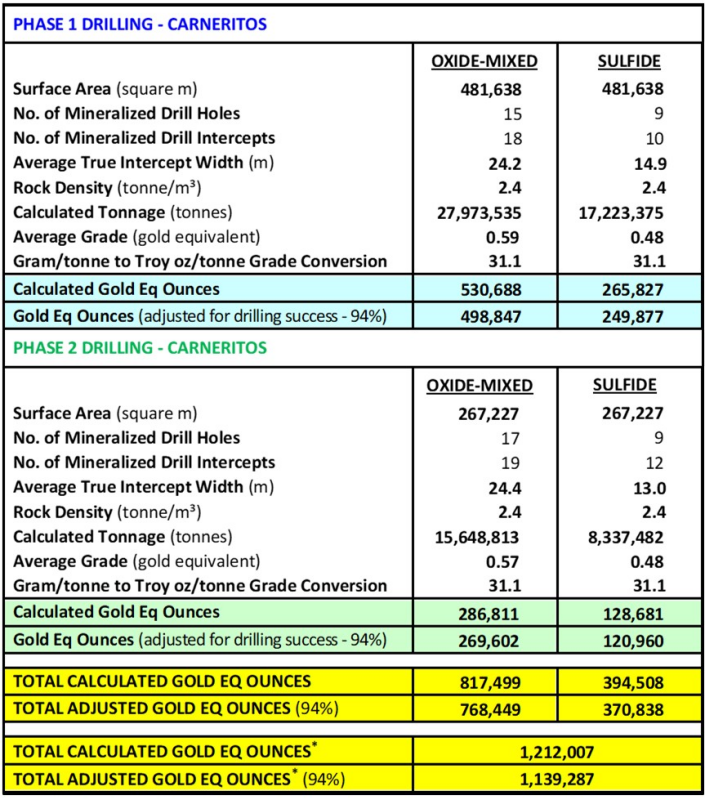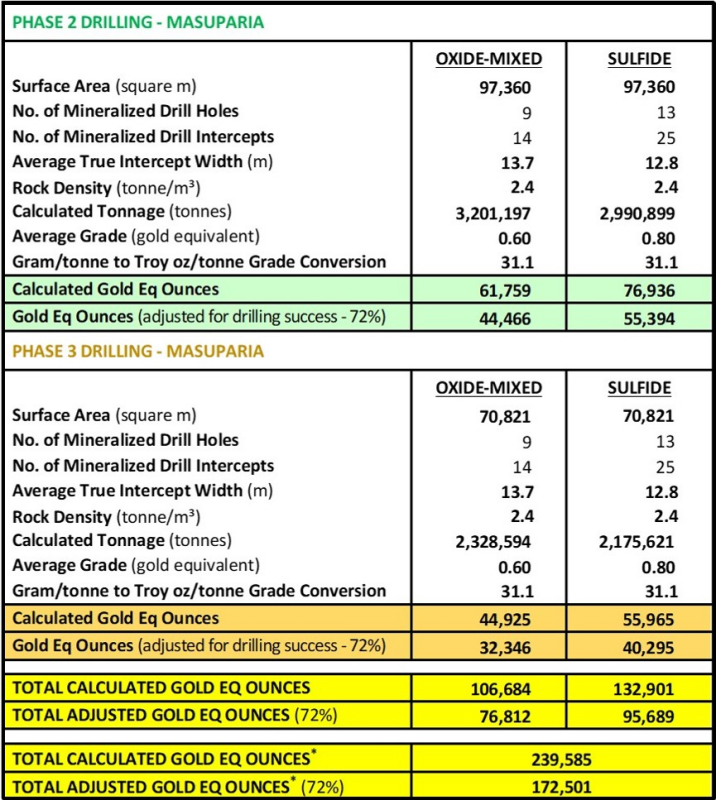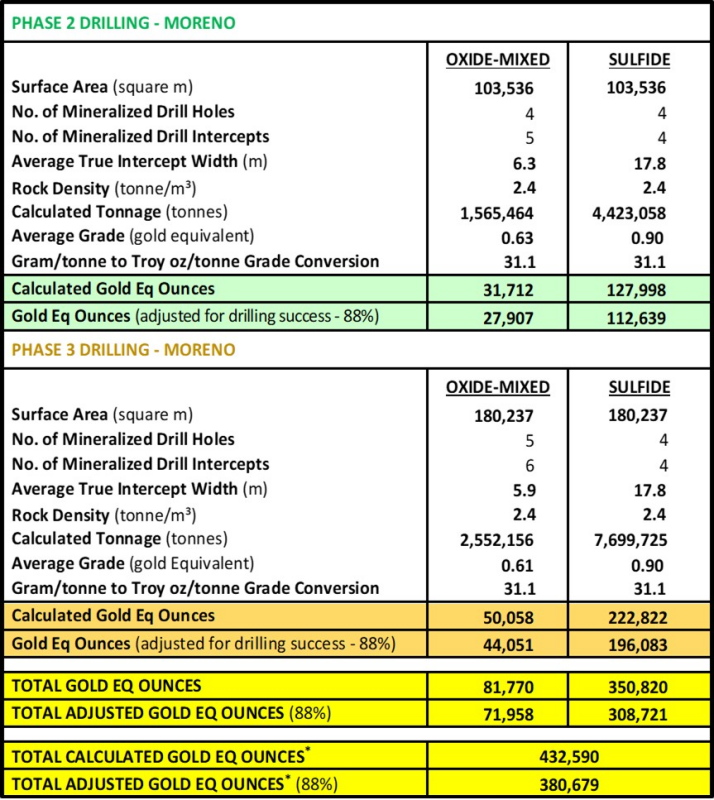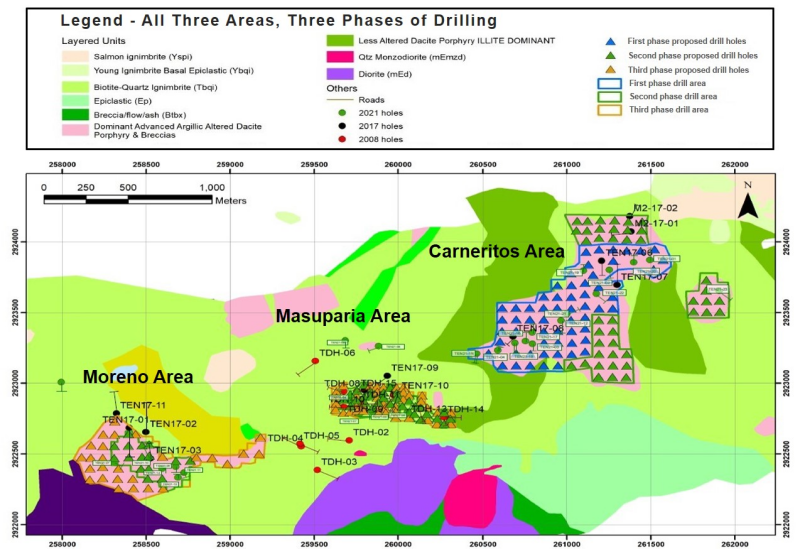Archive
Mammoth Announces Greater than One Million Ounce Gold Equivalent Target for Further Exploration at its Tenoriba, Gold-Silver Property, Mexico
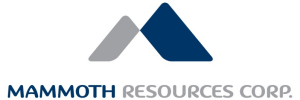 | |||||||||
Toronto, Canada – TheNewswire - (May 15, 2024) - Mammoth Resources Corp. (TSX-V: MTH), (the “Company”, or “Mammoth”) is pleased to announce the results from an internal study performed by Company geologists which identified a target for further exploration (“Exploration Target”, “Target”) at Mammoth’s 100% owned Tenoriba gold-silver exploration property in the Sierra Madre precious metal belt, Mexico. The study was performed under the guidelines of National Instrument 43-101, section 2.3 (2), including: the range of the quantity and grade of the Exploration Target among mixed oxidized-sulfide/transition zone mineralization and sulfide hosted gold-silver mineralization at Tenoriba. The report, available on Mammoth’s website; Projects section, under Technical Reports. describes the basis upon which this Exploration Target has been determined. It should be noted that in accordance with NI 43-101 this Target is conceptual in nature and therefore it is uncertain whether further exploration will result in this Target being delineated.
The range of Exploration Targets is illustrated in the following table.
|
Exploration Target - All Three Areas, All Three Phases of Drilling |
|||
|
OXIDE-MIXED |
SULFIDE |
COMBINED* |
|
|
Total Surface Area (square m) |
1,200,819 |
1,200,819 |
1,200,819 |
|
Total Calculated Tonnage (tonnes) |
53,269,759 |
42,850,160 |
96,119,919 |
|
Weighted Average Grade (gold equivalent) |
0.59 |
0.64 |
0.61 |
|
TOTAL CALCULATED GOLD EQ OUNCES* |
1,005,953 |
878,229 |
1,878,127 |
|
TOTAL ADJUSTED GOLD EQ OUNCES* (90%) |
917,219 |
769,959 |
1,687,178 |
Note: * Sum of Oxide-Mixed plus Sulfide mineralization
Thomas Atkins, President and CEO of Mammoth Resources commented on the results of Mammoth’s Exploration Target study, stating: “I’m very pleased with the results from this study. We always suspected there was a sizable exploration target at Tenoriba given how frequently we’ve sampled gold-silver throughout the property. It’s been rewarding to use our observations of surface geology and the available drill data to determine this potential target.
“Beyond the large 1.8 million gold equivalent target, I’m especially encouraged by the potential that more than 800,000 gold equivalent ounces could exist in the shallow Oxide-Mixed horizon in Carneritos. This near-surface horizon has the potential to be delineated over two phases of what should be a relatively low-cost program of only 59, approximately 50 metre deep drill holes in the first phase, at the recommended 80 metre drill spacing. It’s within this Oxide-Mixed mineralization that our preliminary metallurgical work suggests excellent recoveries that have the potential to be amenable to low-cost heap leach gold recovery.
“Our immediate plans are to obtain quotes from drill contractors to further evaluate the cost of the first phase of shallow drilling focused on delineating the first 500,000 gold equivalent ounce Inferred resource target at Carneritos. Based on past costs, I feel confident that we can drill this shallow horizon at a very compelling cost relative to the opportunity of defining this mineral resource. I believe success at Carneritos can translate to additional successes in further defining a large mineral resource at Tenoriba. Mammoth looks forward to reporting on the cost estimates for the resource delineation drilling in the near future”
Richard Simpson, Vice President Exploration of Mammoth Resources further commented on Mammoth’s Exploration Target, stating: “Following the success of the 2021-22 drill program in delineating the boundaries to the three large areas of gold-silver mineralization at Tenoriba, we recognized that the next step in the advancement of Tenoriba was to define a maiden Inferred mineral resource. This study acts as a guide in determining the risk-reward to further investment at Tenoriba to define this resource.
“We initially began looking at a global, oxidized-mixed oxidized/sulfide domain together with all sulfide mineralized intervals in determining the Exploration Target. It too was a large number of gold equivalent ounces. However, when we saw the high recoveries of gold-silver in the near surface, oxidized-mixed oxidized/sulfide material from the preliminary bottle roll tests, we felt it would be better to separate mineralization into the two domains. We believe there’s excellent potential to define a sizeable mineral resource in low-cost, near-surface drilling of the oxidized horizon, especially in our initial phase drilling at Carneritos.”
Reliance on Information - Methodology for Determining the Exploration Target:
The Exploration Target has been determined for each of the three gold-silver mineralized areas at Tenoriba that span a four kilometre, east-west trend. From east to west the mineralized areas include; Carneritos, Masuparia and Moreno. Gold-silver mineralization within these three areas is separated into two mineralized domains; a surface to shallow oxidized plus mixed oxidized-sulfide horizon/domain (“Oxide-Mixed) and independently a deeper sulfide horizon/domain (“Sulfide”). Combining these two mineralized domains, the Exploration Target is suggested as a range of values based on; (1) 100% success in future resource definition drilling in the three areas, and employing average grades and interval lengths from prior drilling, and (2) a reduced Target based on an average 90% success in prior drilling across all areas (the drill weighted success of prior drilling), and which is also determined and utilized for each of the three individual areas, similarly employing average grades and interval lengths from prior drilling.
The upper range of the Exploration Target is based on 100% success in future drilling and assumes similar averages of grade and mineralized intervals. No allowance in the determination of the Exploration Target has been given for expansions of the three known areas of mineralization in additional areas at Tenoriba.
Thomas Atkins, further commented on the study, stating: “It’s worth noting that this target for further exploration gives no merit to any additional potential outside of the three principal areas of recent exploration. Yet, outside of these areas, gold-silver mineralized is observed in artisanal workings, gold in soil and chip samples and geophysical characteristics exist similar to areas where potentially economical mineralization has been intersected in prior drilling. I think we’ve been very pragmatic in relying on the data available and the success from prior drilling. Our estimates identified a very attractive target and we've not tried to extend the target to consider potential beyond the three principal areas of mineralization.”
The determination of the Exploration Target relies upon an abundance of geological data, including (1) surface geological mapping, (2) many hundreds of gold-silver soil, chip and channel samples, (3) Terraspeck alteration clay sample analysis of surface and drill core, (4) a three-dimensional interpretation of surface geophysical data, and (5) gold-silver values from 55 diamond drill holes. A drill plan, to determine an initial Inferred mineral resource within this Target, follows the recommendations of an independent drill hole spacing analysis. This analysis suggests a drill hole spacing of 80 m between holes at the Carneritos and Moreno areas and spacing of 40 m at the Masuparia area.
The methodology employed to calculate the target for further exploration included the determination of: (1) the surface area of potentially economically mineralized material based on available surface geological, sample and drill data, (2) segregation of the target for further exploration into two mineralized horizons/domains; a mixed oxidized-sulfide/transition zone domain and separately a sulfide domain, (3) estimated true width of drill core intervals grading above a 0.18 g/t gold equivalent cut-off grade, (4) rock density, and (5) taking into account the success of prior drilling intersecting potentially economical gold-silver mineralized intervals in each of the three target areas at Tenoriba. The target for further exploration was assigned a range based on two parameters; 100% success in future drilling and this upper level reduced based on the success of prior drilling having intersected potentially economical intervals of gold-silver mineralization.
Based on the historical geological data and the methodology employed, a range for the target for further exploration was determined for each of the three target areas within the two mineralized horizons/domains. Combining the two domains, the target for further exploration at 100% success in future resource drilling, employing average grades and interval lengths from prior drilling was 96,119,919 tonnes at a grade of 0.61 g/t gold equivalent totalling 1,871,624 gold equivalent ounces. The combined domain target for further exploration, based on an average 90% success in prior drilling across all areas, and employing average grades and interval lengths from prior drilling was 1,687,178 gold equivalent ounces.
The Company recommends that based on the combination of many hundreds of gold-silver sample values observed on surface and in drill core within the three principal areas of mineralization at Tenoriba, coupled with the high rates of gold-silver dissolution-recovery from the preliminary metallurgical tests and the range of values calculated for the Exploration Target, that resource definition drilling to define an Inferred mineral resource following the recommended drill hole spacing, be advanced in the suggested three phases of drilling at Tenoriba.
Exploration Targets:
The suggested drilling to delineate a maiden Inferred mineral resource at Tenoriba, within the three target areas; Carneritos, Masuparia and Moreno are illustrated in Figure 1 - Location Map, Drill Hole Collar Locations, Exploration Target Drilling, Tenoriba. Additional information and images on the Target areas is available in the report on the Exploration Target study on Mammoth’s website. The determination of the Exploration Target relied on prior drilling which intersected potentially economical intervals of gold-silver mineralization within the designated surface areas.
Prior drilling was 94% successful in encountering potential economical gold-silver mineralized intervals in historic drilling, with this ratio of success establishing the lower range of the Target. The upper end of the range is based on 100% success in future resource definition drilling. The range of the Target, in each of both the Oxide-Mixed and the Sulfide domains over two phases of drilling and the resulting, combined Target is illustrated in Table 1. Exploration Target Calculation Parameters - Phase 1 and Phase 2 Drilling, Carneritos Area.
Table 1. Exploration Target Calculation Parameters - Phase 1 and Phase 2 Drilling, Carneritos Area.
Masuparia Area:
Prior drilling was 72% successful in encountering potential economical gold-silver mineralized intervals in historic drilling, with this ratio of success establishing the lower range of the Target while the upper end of the range is based on 100% success in future resource definition drilling. The range of the Target, in each of both the Oxide-Mixed and the Sulfide domains over two phases of drilling and the resulting, combined Target, are illustrated in Table 2. Exploration Target Calculation Parameters - Phase 2 and Phase 3 Drilling, Masuparia Area.
Table 2. Exploration Target Calculation Parameters - Phase 2 and Phase 3 Drilling, Masuparia Area.
Moreno Area:
Prior drilling was 88% successful in encountering potential economical gold-silver mineralized intervals in historic drilling, with this ratio of success establishing the lower range of the Target while the upper end of the range is based on 100% success in future resource definition drilling. The range of the Target, in each of both the Oxide-Mixed and the Sulfide domains over two phases of drilling and the resulting, combined Target, are illustrated in Table 3. Exploration Target Calculation Parameters - Phase 2 and Phase 3 Drilling, Moreno Area.
Table 3. Exploration Target Calculation Parameters - Phase 2 and Phase 3 Drilling, Moreno Area.
Quality Assurance and Quality Control (QA/QC):
All data provided for this drill spacing study followed QA/QC controls as outlined on the Mammoth Resources website, “News” and press releases spanning the period November 18, 2021 to December 15, 2022.
Qualified Person(s)/Competent Person(s) (QP/CP):
Richard Simpson, P.Geo., Vice-President Exploration for Mammoth Resources Corp. is Mammoth's QP/QC under National Instrument 43-101 by virtue of his professional designation, university degree and years of work experience as a geologist and is responsible for and has reviewed all technical data in this release (refer to Mammoth’s website “Projects”, “Qualified Person/Competent Person” section for Mr. Simpson’s qualifications).
About Mammoth Resources:
Mammoth Resources (TSX-V: MTH) is a precious metal mineral exploration Company focused on acquiring and defining precious metal resources in Mexico and other attractive mining friendly jurisdictions in the Americas. The Company holds a 100% interest (subject to a 2% net smelter royalty purchasable anytime within two years from commencement of commercial production for US$1.5 million) in the 5,333-hectare Tenoriba gold property located in the Sierra Madre Precious Metal Belt in southwestern Chihuahua State, Mexico. Mammoth is seeking other opportunities to option exploration projects in the Americas on properties it deems to host above average potential for economic concentrations of precious metals mineralization.
To find out more about Mammoth Resources and to sign up to receive future press releases, please visit the company's website at: www.mammothresources.ca., or contact Thomas Atkins, President and CEO at: 416 509-4326.
Neither the TSX Venture Exchange nor its Regulation Services Provider (as that term is defined in the policies of the TSX Venture Exchange) accepts responsibility for the adequacy or accuracy of this release.
Forward Looking Information: This news release may contain or refer to forward-looking information. All information other than statements of historical fact that address activities, events or developments that the Company believes, expects or anticipates will or may occur in the future are forward-looking statements; examples include the listing of its shares on a stock exchange and establishing Mineral Resources. These forward-looking statements are subject to a variety of risks and uncertainties beyond the Company's ability to control or predict that may cause actual events or results to differ materially from those discussed in such forward-looking statements. Any forward-looking statement speaks only as of the date on which it is made and, except as may be required by applicable securities laws, the Company disclaims any intent or obligation to update any forward-looking statement, whether a result of new information, future events or results or otherwise. Although the Company believes that the assumptions inherent in the forward-looking statements are reasonable, forward-looking statements are not guarantees of future performance and, accordingly, undue reliance should not be placed on these forward-looking statements due to the inherent uncertainty therein.
Figure 1 - Location Map, Drill Hole Collar Locations, Exploration Target Drilling, Tenoriba
